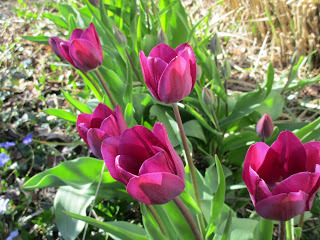Robert Knox's Blog, page 41
May 8, 2016
The Garden in May: A Little Light on the Situation
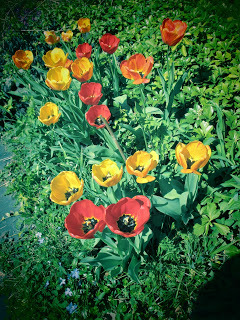 Lots of greens, different shades of green, and lots of other colors too. What makes the spring garden come alive? A little sunlight.
Lots of greens, different shades of green, and lots of other colors too. What makes the spring garden come alive? A little sunlight. I keep waiting for this month to begin. In the Boston area, it has rained at least a measurable amount every day this month. And every day last week the temperature was below average for the month of May. On Friday, a northeaster
gale blew off the sea, with intimidating sound effects. I kept thinking very loud, low-flying jets buzzing the house for some reason, probably because they know I don't like them. This was the shocking music of a heavy wind day in a winter storm; not of the end of the first week in May.
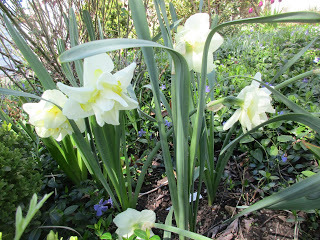 No part of which is bothering the plants. They all needed the moisture. And how rugged are, for instance, tulips? The opened their mouths and showed their tonsils, and the cool damp weather keeps the blossoms from drying out. They couldn't be happier. Is that the secret of tulip-growing in Holland? The daffodils fared worse. A number tall skinny stems holding elaborate narcissus variety flower heads have been crimped and loll to one side or another.
No part of which is bothering the plants. They all needed the moisture. And how rugged are, for instance, tulips? The opened their mouths and showed their tonsils, and the cool damp weather keeps the blossoms from drying out. They couldn't be happier. Is that the secret of tulip-growing in Holland? The daffodils fared worse. A number tall skinny stems holding elaborate narcissus variety flower heads have been crimped and loll to one side or another. 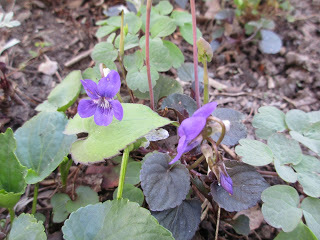 The tiny Labrador violets (third photo down), I'm happy to see, are making a comeback. They fit into spaces unclaimed by larger species. They have dark purple violets, accompanied by dark leaves with purple in them as well, making for aesthetic interest close to the ground. You have to get low to visit them. It's worth it; they reward discovery. But I can never predict where they will from year to year.
The tiny Labrador violets (third photo down), I'm happy to see, are making a comeback. They fit into spaces unclaimed by larger species. They have dark purple violets, accompanied by dark leaves with purple in them as well, making for aesthetic interest close to the ground. You have to get low to visit them. It's worth it; they reward discovery. But I can never predict where they will from year to year. 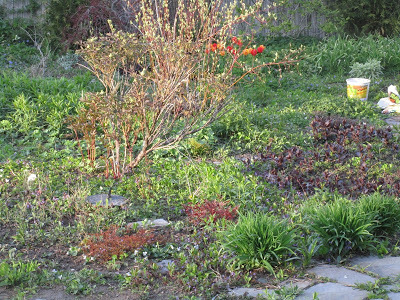 The pictures on this page were all taken a week ago on a cool, but bright late Saturday afternoon, before the oppressive run of darker, wetter days began. Since they were actually taken on April 30, what they show is a pre-May moment. I like looking at plants in their youthful, immature state -- it's the change as much as the finished product that intrigues me.
The pictures on this page were all taken a week ago on a cool, but bright late Saturday afternoon, before the oppressive run of darker, wetter days began. Since they were actually taken on April 30, what they show is a pre-May moment. I like looking at plants in their youthful, immature state -- it's the change as much as the finished product that intrigues me. 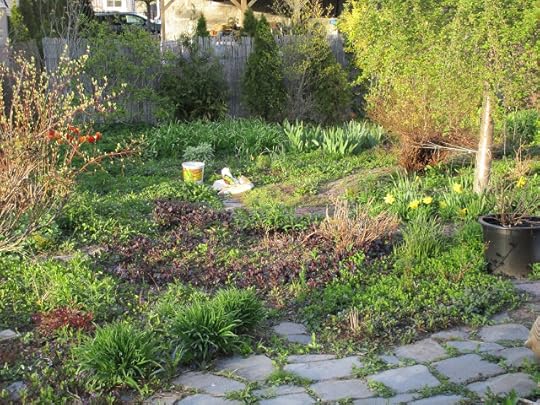 The four last photos on this page, taken from wider angles, interest me just for the range of plant forms, shapes, and varieties of perennials in this half-grown or quarter-grown state. Some of those reddish plants, Astilbe will launch tall stems with feathery flowers. Other low purplish colonies, called loosestrife, grow stems several feet high and produce yellow flowers.
The four last photos on this page, taken from wider angles, interest me just for the range of plant forms, shapes, and varieties of perennials in this half-grown or quarter-grown state. Some of those reddish plants, Astilbe will launch tall stems with feathery flowers. Other low purplish colonies, called loosestrife, grow stems several feet high and produce yellow flowers. 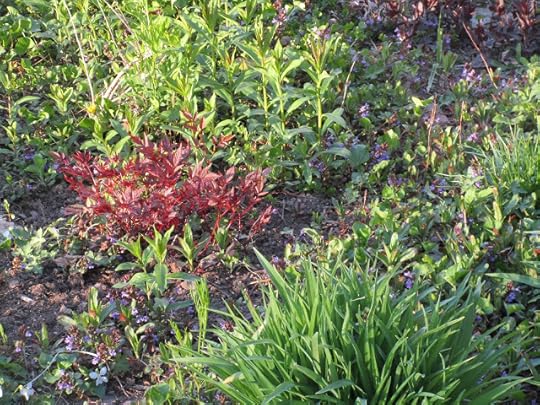 Most of the low groundcovers that are flowering now will stop flowering by the end of the month. Many of them will scarcely be visible when their larger neighbors take up all the air space above them.
Most of the low groundcovers that are flowering now will stop flowering by the end of the month. Many of them will scarcely be visible when their larger neighbors take up all the air space above them. 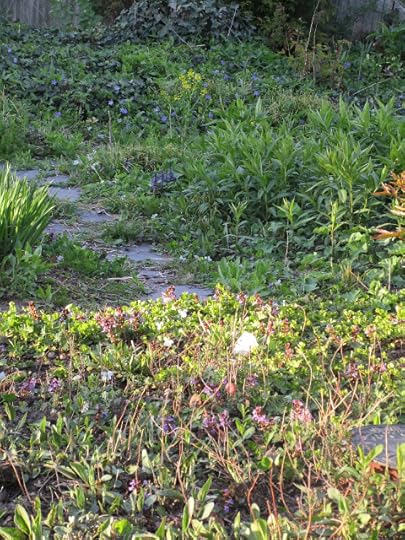
Published on May 08, 2016 20:12
May 5, 2016
Delving Into Poetry Month: Thirty Days of Planting Words
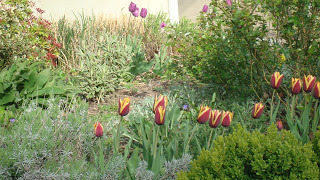 April is (or now was) National Poetry Month, a nice designation but nothing near the impact of a national holiday. Emily Dickinson's birthday maybe? Or Walt Whitman's?
April is (or now was) National Poetry Month, a nice designation but nothing near the impact of a national holiday. Emily Dickinson's birthday maybe? Or Walt Whitman's? Still, poets get excited about it in sort of busman's holiday way. Let's write more poems this month, they say. Let's write a poem every day. A National Poetry Month website encourages this workaholic tendency, offering clever and original prompts on each of the month's 30 days. In fact, any number of other websites do a similar thing.
Prompts are a new discovery for me, perhaps an invention of the instant communication possibilities of the digital age. If someone says, 'why don't we all write a poem about trees, or birds, or women whose image deserves to be on the twenty dollar bill?' you could say that was a prompt. But things are considerably more elaborate in the industry these days.
Here, for example, is the National Poetry Month [http://www.napowrimo.net/] website's prompt for the April 24th:
Today I challenge you to write a “mix-and-match” poem in which you mingle fancy vocabulary with distinctly un-fancy words. First, spend five minutes writing a list of overly poetic words – words that you think just sound too high-flown to really be used by anyone in everyday speech. Examples might be vesper, heliotrope, or excelsior. Now spend five minutes writing words that you might use or hear every day, but which seem too boring or quotidian to be in a poem. Examples might be garbage disposal, doggy bag, bathroom. Now mix and match examples from both of your lists into a single poem. Hopefully you’ll end up with a poem that makes the everyday seem poetic, and which keeps your poetic language grounded.
Or kinda wicked paradoxically incongruous.
Nevertheless I gave the monthly project a try, working not everyday but with a start and stop rhythm. I frequently fell three or four days behind and went doggedly back to the days I missed to try to catch up. And while I never did get to all 30 prompts, I enjoyed the process. Two of the poems I wrote this way turned into 'garden theme' poems and appear in this month's Verse-Virtual.
They are titled "Visiting Roses: Under the 'Lune' " and "A Family Garden." [www.verse-virtual.com/robert-c-knox-2...]
"Visiting Roses" originated with a prompt to write in a poetic form called a "lune":
This is a sort of English-language haiku. While the haiku is a three-line poem with a 5-7-5 syllable count, the lune is a three-line poem with a 5-3-5 syllable count. There’s also a variant based on word-count, instead of syllable count, where the poem still has three lines, but the first line has five words, the second line has three words, and the third line has five words again. Either kind will do, and you can write a one-lune poem, or write a poem consisting of multiple stanzas of lunes.
"A Family Garden" came from this prompt: ...write a poem that takes the form of a family portrait. You could write, for example, a stanza for each member of your family. You could also find an actual snapshot of your family and write a poem about it, spending a little bit of time on each person in the picture. You don’t need to observe any particular form or meter.
A more challenging prompt introduced me to the form of the "tritana."
The tritina is a shorter cousin to the sestina, involving three, three-line stanzas, and a final concluding line. Three “end words” are used to conclude the lines of each stanza, in a set pattern of ABC, CAB, BCA, and all three end words appear together in the final line.
Confused? No problem — here’s an example!
I did read the illustrative tritana, and liked it. The poem that resulted from this formal challenge, titled "The Slow Tritina We Will Dance," has been accepted by another literary journal for an upcoming issue. Never too late, I guess, to learn something new.
One last offering from my month's work, to illustrate the range of the imaginative and wholly unpredictable universe of the 'prompt.' (There is no end to it.) Here's the prompt for June 17:
I challenge you to find, either on your shelves or online, a specialized dictionary. This could be, for example, a dictionary of nautical terms, or woodworking terms, or geology terms. Anything, really, so long as it’s not a standard dictionary! Now write a poem that incorporates at least ten words from your specialized source.
I found a dictionary of geological terms that attracted me because on the first page appeared "alluvial fan." I loved the double meaning possibility there. Here's the resulting poem, with notes below to explain the unfamiliar terms.
School of Hard Rocks
The Alluvian Fan is rooting for mudWhile the Spirit of New Mexico prays for dry weather to save his handsome ButteA Density Current pores through the country with an angry thump:many votes for Donald Trump.An increased dip in a dipping trend says Monocline is now your friend,while tumbling on Scree in a bald Reverse Fault, a stumbling Roughneck calls a halt. Put down your cup of early joe and help me wind yon PahoehoeIt coils around the Tourmalines that color grew in deeper mines And persevered through many fights with blind, albino Troglobites The Caldera yawns at Yellowstone While for its loss a Cation moansIn deeper days in heavy dirtA crystal nodule strives for Chert Attorneys for the Deeps in opposition Await a geological DepositionTo rule at last, without dispute That Fossil Fuels aren't worth a Hoot
[NOTES from a glossary of geological terms: http://geology.com/geology-dictionary... Fan:A fan-shaped wedge of sediment that typically accumulates on land where a stream emerges from a steep canyon onto a flat area.
Density Current:
A gravity-driven flow of a dense fluid down a slope through a fluid of lower density
Monocline: An area of increased dip in otherwise gently dipping strata.Scree: A mass of small loose stones that form or cover a slope on a mountain.
Pahoehoe: A Hawaiian term for a lava flow that has a surface flow structure that looks like coiled rope or cord.
Tourmalines: a crystalline boron silicate mineral compounded with elements such as aluminium, iron, magnesium, sodium, lithium, or potassiumTroglobites:Small creatures that have adapted to a permanent life in a cave.
Caldera: A large, bowl-shaped crater associated with a volcanic vent Cation: An atom with a positive charge that has been produced by the loss of one or more electrons.Chert: The precipitation of chemical sediments from mineral rich waters. Deposition: A word used in reference to sediments or sedimentary rocks that are composed of particles that were transported and deposited by wind, water or ice.Hoot: Slang sense of "smallest amount or particle"]
DAY TEN She challenges us to write a “book spine” poem. This involves taking a look at your bookshelves, and writing down titles in order (or rearranging the titles) to create a poem. Some fun images of book spine poems can be found here. If you want to take things a step further, Lillian suggests gathering a list of titles from your shelves (every third or fifth book, perhaps, if you have a lot) and using the titles, as close to the originals as possible, to create a poem that is seeded throughout with your own lines, interjections, and thoughts. Happy writing!
Far Side
The Far Side of the World We travel when the wind is fair One Palestine CompleteTurn the pages back on time's mistakesAfter King Philip's War, Mayflower, The Invasion of Europe by the EuropeansTime's Last Chance and Other RiddlesLaws of Number, Excluded Middles,The World Without Us, Shame of the Cities,Clever Men and Clever DittiesEye of the Storm by Namesake Knox Wings Over Cape Cod and Ancient RocksThe Journal of Albion Moonlight and All Such Stuff from Other DaysLord of Chaos rules The WaysFestive Time and Haunted HoursA Field Guide to Wild Trees and FlowersNew England Mysteries All Must Fear The Tempest, The Inferno, and King Lear Tragedy in Dedham, Marcel Proust AlongSwann's Way, Falkner's Hamlet, Old Will's PlayFlorida and Samarkand, Places we will find to standand dip our toes in soothing sandBut don't forget Blue Fruit for Sal, or Toad for Owl, Something to Beguile the Hour,The Day We Ran Away, Adventure Calls,Defiance Hurled, Taking Daddy's Little Girlto The Far Side of the World
School of Hard Rocks
The Alluvian Fan is rooting for mudWhile the Spirit of New Mexico prays for dry weather to save his handsome ButteA Density Current pores through the country with an angry thump:many votes for Donald Trump.An increased dip in a dipping trend says Monocline is now your friend,while tumbling on Scree in a bald Reverse Fault, a stumbling Roughneck calls a halt. Put down your cup of early joe and help me wind yon PahoehoeIt coils around the Tourmalines that color grew in deeper mines And persevered through many fights with blind, albino Troglobites The Caldera yawns at Yellowstone While for its loss a Cation moansIn deeper days in heavy dirtA crystal nodule strives for Chert Attorneys for the Deeps in opposition Await a geological DepositionTo rule at last, without dispute That Fossil Fuels aren't worth a Hoot
Published on May 05, 2016 20:34
May 4, 2016
The Garden of Verse: And Lots of Verse on Gardens in May's Verse-Virtual
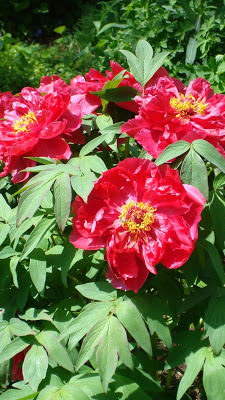 The theme for the May edition of Verse-Virtual was gardening (or gardens, or flowers), though the online poetry journal is always open to poems on any subject.
The theme for the May edition of Verse-Virtual was gardening (or gardens, or flowers), though the online poetry journal is always open to poems on any subject."I wasn't too sure about the appeal of the FLOWERS theme for May (because it's so simple and perhaps overused)," editor Firestone Feinberg writes. "[But] the flower poems in this issue are amazing. What a display of pure creativity and profound inspiration."
After a first sampling of May's garden of verses here are some of the poems that stay with me. I'll plant them in my memory and hope they root.
Dick Allen delivers an entire flower garden in his three poem. "Homefront" offers us the chilling picture of sunflower heads cut off by a storm and discovered by children hanging on wire cages.
"They frightened us ... as if they were children who become
adults too soon, the darkness at their roots/
sensed by other children..."
What an insight! Something eerie but true here. Children's perception powers of perception differ from their elders', especially when it comes to sensing the macabre. When we grow up we 'know better.' We know the grotesque sensation is not 'real,' and we're unlikely to share it. I think I must have slept through childhood; other people have such interesting things to say about it. Lively descriptions in an amusing poem about the poet's settled dislike mark "African Violets." Personally I like them fine, but I'm impressed by the language of the indictment here: "over-propagating, squirming in their pots,
their Disney mouse-ear petals fluttering..."Allen also gets the essence of "Black-eyed Susans," an ubiquitous and ambitious native plant that, just as the poet says, arrive uninvited "traipsing
over meadows and fields,
trailing the borders of our neighbors’ gardens,
cartwheeled
into the green apron of every summer,
their dark domed eyes
all wide open,
unapprised
(as they waver under our mailbox,
scatter their different heights across our yard)..."
A beautifully vivid and apt evocation of something I see every summer. I was delighted to encounter a poet familiar with "plumeria," a flower word I've been meaning to run down for a couple of years. Donna Hilbert depicts it (in words and an excellent photo) "by the front door" blooming "velvet yellow among/ green leaves." I'm also much affected by her poem ("Flowers") implicitly comparing plants to women as embodiments "of a certain age." Certain flowers, the poet writes, "have a languorous grace
leaning over the lip of the vase
as if standing straight were too much
trouble. (Think hookers in a humid city.)"
William Greenway's poem "Heart" gets to the heart of the matter with memorable language. After a visit to the doctor, he pictures (recollects? imagines?) his father's desperate response to an attack, and then turns to his own sense of vulnerability: "You see yourself as glass
for the first time, transparent,
shaken and fizzing, and start
watching for potholes.
Or maybe you just learn to live
with a cart with square wheels
thudding in your breast
trying to carry whatever it is
there,
before it's too late."Some very apt and moving images here.
Laura Kaminski offers a bouquet of three poems written in response to three poems published previously in Verse-Virtual. Since one of them is a poem I wrote, I'm a biased reader. But I can't help sharing my pleasure when (in "Rough Beast") the poet compares our attempts to guard our emotions to "Cerberus-class security." Cerberus (that mythically attentive watchdog), the poem continues, was "charged with keeping those already in the chasms
of the underworld from leaving the Hades,
shades of our own making, dark caverns
of stagnation."
This potent way of describing Hades reminds me of Milton's Satan discovering "myself am hell."
Another Greek myth makes an appearance in Jim Keller's poem .After you read the title "Zeus as Oncologist" (which is pretty funny already) the kick you get from the first two lines "So how do you feel today Prometheus?
Is the pain any better?"makes me believe that laughter is indeed the best medicine. It turns out that Prometheus has to deal with what our ghoulishly cheerful oncologist calls "your type of cancer," Aetos Kaukasios. After a search, I learned these words mean the giant eagle that is eating Prometheus's liver. What a guy, that Zeus.
Back to flowers, wildflowers in particular. Joan Mazza's "May Wildflowers in Virginia" shows us that a lot of knowledge can be a good thing. The poem includes a fine photo of lady slippers with (as the poem says, quite accurately) "their pink scrota.” Names have their magic. Here are a few:"We slow down, bend to see
each flower I missed
on my morning walk...We peer into common elder, scarlet clover,
dead nettle, white and pink dogwood,
count twenty-six species,
lose track of time,surrounded by wild purple azaleas."
Robert Wexelblatt shares two poems about a Mrs. Oleander, the name of a flowering shrub I will never grow outdoors in New England. The poems are about cultivating relationships, or perhaps a "cultivated" attitude toward them. In the first Mrs. Oleander enjoys Martinu's music (a learned taste for a modern composer) and relies on "something fragrant on the stove" to maintain the appearance of love with a compliant, perhaps not very observant husband. In the second ("Adieu"), a lover ultimately rejects a relationship with Mrs.O. based on appearance and canniness, but not really love, concluding, "you are what you love not what you pay."
Victoria Melekian has written a poem I can relate to ("The Sentinel Node") about watching the dye that identifies which node has to be examined to see if a cancer has spread. I can't help wondering (since this is the 'garden' issue), will it blossom, flower, branch? (Has anybody written a poem called "The Garden of the Self"?) I won't ruin the ending but I will quote one beautiful image: "The white dot on the screen looks like
the first star in a blue-black dusk."
Robbi Nestor introduces us to flower royalty in her precise portrayal of "The Queen of the Desert," who rules her kingdom for one perfectly blooming night. This is clearly, the poet writes:"an effort to employ olfactory wiles
in service of the seed, attracting
avid Sphynx moths and bats,
metallic scarabs like bouncers
in their glittering regalia.
A scent strong as a snare,
tangible as the bug-eyed peepers’
insistent shrilling in the sodden leaves."
After reading lines like these -- and so many others blooming on the pages of May's Verse-Virtual -- can we doubt that the world of the garden is really a place to grow metaphors, harvest images, and feed the senses to grow the imagination?
Here's the link to the May issue of Verse-Virtual.
http://www.verse-virtual.com/current-...
In April the journal received more than 20,000 page views.
Published on May 04, 2016 09:05
May 1, 2016
The Garden of History: Celebrating the Roots of the Eight-hour Day
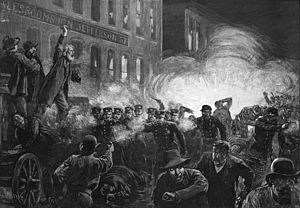 Today is Primo Maggio (the first day of May), celebrated as Labor Day in much of the world, though not in the United States, to remember the achievements of the trade union
Today is Primo Maggio (the first day of May), celebrated as Labor Day in much of the world, though not in the United States, to remember the achievements of the trade union movement in bettering the lives of working people. According to the Italian version of Wikipedia (through a dodgy translation), "the holiday marks the workers' struggles, especially those aimed at the conquest of a precise right: the daily working hours shall be eight hours."
Most of us have worked a 40-hour week, or something close to it, at one time or another. If we work in offices or professions with 'regular' hours -- banks, insurance, law offices, finances, dentists, retail, the "9 to 5" world of secretarial or clerical or sales jobs -- the 40-hour standard plays a role in the calculation of our working week. With built-in allowances for lunch, some employers describe their work week as 35 or 37.5 hours.
Those of us born during the Cold War era will probably associate May 1st as the day when TV news showed us pictures of large, darkly threatening parades in the Soviet Union marked by a display of military might, lots of tanks and trucks pulling artillery pieces and jets flying overhead. And perhaps similar displays for press-ganged crowds lining the streets in East Berlin, Warsaw, Prague and the other capitals in the Soviet bloc.
Like most everything that happened during the Cold War, the state-sponsored military parade was a perversion of a significant idea. Around most of the world May Day commemorates the struggle of workers -- a class of employees distinct from owners, bosses, management, or stockholders -- to achieve an eight-hour day. A struggle that began in the USA.
"Few Americans seem to realize that May Day came about to memorialize an American event -- the execution of the Haymarket martyrs in 1887," anarchist historian Robert D'Attilio wrote in a book review 20 years ago. The eight-hour day was what workers in Chicago's Haymarket Square were rallying for in 1886 when a bomb went off and riot broke out, killing and wounding both workers and police.
The history of May Day (or "primo maggio") begins there. It's important to keep in mind that in the decades following the Civil War, when industrial expansion took off in America, the standard working week was the 60-hour, 6-day week. Given that activities on Sunday were restricted by rules requiring businesses to be closed on the Sabbath, the lives of industrial works were largely restricted to labor, sleep, and the tavern. Seeking a nationwide 8-hour day, thousands of workers throughout the United States went on strike on May 1, 1886, and big rallies were held to back the demand for the "Eight-hour day with no cut in pay." Nationwide up to half a million workers went on strike, and about 10,000 turned out in Chicago for a demonstration.
A confrontation between workers and strike-breakers at the gates of the McCormick factory in Chicago turned deadly when police fired on and killed two workers. Labor leaders called for a rally in response the following day in Haymarket Square. When police decided to break up a peaceful meeting, someone threw a bomb in their direction, killing one officer and wounding 6 others. Then police began firing in panicky confusion into the fleeing crowd, killing four demonstrators and wounding scores of others.
In a dark and crowded setting police officers also mistakenly fired at one another. Accounts of final casualty figures differ; but a rough consensus is that seven policemen and at least four workers were killed; some 60 policemen were wounded and estimates of wounded civilians run even higher.
The official response concentrated solely on the bomb-throwing, for which anarchists were blamed without evidence. The rally's speakers were also arrested and charged with causing a riot. In the end 8 strike leaders, 5 of them German immigrants,were put on trial for murder, without evidence that any of them had thrown the bomb. Seven were sentenced to death, one to prison.
Internationally, the event played out much as the Sacco-Vanzetti case would 40 years later. Demonstrations were held to mark the May 1st execution of the "Haymarket martyrs," and may countries recognized May First as an official labor holiday.
In the United States, our government chose create the Labor Day holiday in September because American politicians wished to distance it from a cause celebrated by labor and other left-wing groups.
But we should remember that when workers in other countries (and, occasionally, here) celebrate May First, they are commemorating a struggle for the 8-hour day that began in America and the American labor leaders who paid for that cause with their lives.
Published on May 01, 2016 22:37
April 30, 2016
The Garden of Experience: Still Learning About Vanzetti's Era in Old North Plymouth
 Sixty-five people turned up for my Authors Series program in Kingston last week, certainly more than I anticipated. It was a great evening, though I botched the challenge of holding a microphone in one hand while speaking -- especially while trying to read from "Suosso's Lane" with the other (but even when simply speaking from hand-held notes). Things got so bad that a friend emerged from the audience, manifesting by my side as if from nowhere (like Athena in the Iliad), and held the mike steady for the entire remainder of my presentation. Note to self: make sure there's a fixed microphone holder before you attempt public speaking again.
Sixty-five people turned up for my Authors Series program in Kingston last week, certainly more than I anticipated. It was a great evening, though I botched the challenge of holding a microphone in one hand while speaking -- especially while trying to read from "Suosso's Lane" with the other (but even when simply speaking from hand-held notes). Things got so bad that a friend emerged from the audience, manifesting by my side as if from nowhere (like Athena in the Iliad), and held the mike steady for the entire remainder of my presentation. Note to self: make sure there's a fixed microphone holder before you attempt public speaking again. I keep learning from this experience. Another thing I learned is that my book's peculiar title, "Suosso's Lane," wakes memories.
Explaining her interest in the book, one would-be reader told me that her grandparents on both sides were immigrants who settled in North Plymouth. One side of her family owned the property where a school was built (Vanzetti was employed as a laborer during its construction), operated a store, and offered lodging on one the neighborhood's main streets. Her grandparents on the other side ran a bakery and made and delivered Italian horn bread. Another of her relatives from the early days lived on Cherry Street, still a main street and the one where Vanzetti spent his final year in Plymouth, boarding at the home of Mary Fortini.
Italian horn bread does not receive a mention in the novel "Suosso's Lane," though I'm sorry now that I overlooked it. (However, I did find this story about the "beloved Italian specialty, only in North Plymouth" written by my former Globe colleague Christine Legere at http://capeannonline.yuku.com/topic/6...)
"Suosso's Lane" is largely about politics, society, conflict between big money and poor laborers, anarchists, bombs, a miscarriage of justice, and the consequences of these conflicts on many lives.
And yet one of the side effects -- and benefits, perhaps -- is that the tough story of the Sacco-Vanzetti case with which the book primarily concerns itself wakes memories, and possibly interest, in a very different, but real time in America. There are lessons we can can learn from that time.
One big lesson concerns immigration itself. Those grandparents and other ancestors who immigrated to the US from countries where opportunities were in shorter supply to a place where opportunity for betterment and freedom of thought went hand in hand did become Americans -- and in a relatively short time. The twentieth century, for all its social and economic problems, absorbed people from other places and turned them from "others" to "us" in a relatively short time.
However, in the century's early decades many native-born Americans believed the United States was being overrun and weakened by newcomers, mostly from southern and eastern Europe. They particularly despaired over the number of people who were coming here from Italy. This is a truth I did not fully appreciate until reading and researching for a book about Vanzetti's Plymouth.
Under the weight of national prejudice against Italians -- and also Poles, Russians, Serbs, Jews, Greeks, Portuguese, Syrians and others -- the fear of subversion and revolution prompted by the Russian Communist Revolution in 1917, the opposition of American socialists, anarchists and others to the country's participation in World War 1, anarchist bombs and the Red Scare, America began to narrow its borders in the 1920s. The first restrictive act aimed at the new immigration was called the Italian Exclusion Act. When Calvin Coolidge signed it in 1924 he said (to paraphrase), 'it's obvious that some groups will just never learn to live in a democratic society.'
Has any prediction ever been more wrong? The phone books everywhere today are full of the descendants of the Italian, Polish, Jewish, et al. immigrants from the late 19th and early 20th century.
When I was looking for memories of Vanzetti's days in Plymouth, I spoke to a man who grew up in North Plymouth, told me his father (now deceased) knew all about the Sacco-Vanzetti case, and now lived himself in another part of Plymouth. Italian Americans live all over Plymouth, he told me.
"Italians in Chiltonville," he said, referring to a part of town with large expensive properties and residents who can trace their ancestry back to Plymouth's beginnings. "Imagine that. My grandfather would have never believed it."
Published on April 30, 2016 21:00
April 26, 2016
The Garden of Digital Fowers: I Added a Dot.Com to My Name
 Website, website on the wall, who's the vainest of them all? Add a dot.com to the end of your name and, voila, you have a website. In this case http://robertcknox.com/
Website, website on the wall, who's the vainest of them all? Add a dot.com to the end of your name and, voila, you have a website. In this case http://robertcknox.com/Not that easy of course. But it got a lot easier for me when I hired someone, a friend of my sister's from childhood who happens to be great at these things, to design and build it.
The primary motive, of course is to promote myself as a writer, so here I am -- a self-promoter. Maybe I should tell myself things such as 'If Walt Whitman were alive today, you'd be seeing his name all over the internet.' Whitman paid for the publication of his mid-19th century masterpiece "Leaves of Grass," which sold very, very slowly despite his efforts to promote it such as writing anonymous reviews praising it in newspapers and other journals. And by printing Ralph Waldo Emerson's famous praise-words ("I greet you at the start of a brilliant career") on the cover of the book's next edition without Emerson's permission. Great scandal; few extra sales.
So self-promotion has a long history. If Shakespeare's company (known as "The Lord Chamberlain's Men" and then "The King's Men") was around today, his plays would be on Broadway every year, battling it out with "Hamilton" for headlines. I'm not sure the bard would be above giving talks explaining his success to the contemporary equivalents of Elizabethan joint-stock companies. How much did Hillary get for that again?
So here I am, someone long convinced that his personal ambitions were extremely moderate, doing what everybody else in this era of ceaseless hustle is striving to do: become a brand.
I'm branding myself: robertcknox.com.
I should probably have it tattooed somewhere. Actually, that's where I draw the line.
When I think about how I've been running around, mentally, telling myself 'you'd better get a website,' I keep hearing the arch-satirist Tom Lehrer's classic parody of the spread of nuclear weapons: "you'd better get a bomb!"
All right, enough with the apologies: I have a website. It comes with its own blog. Here's an excerpt from the maiden post, which went live yesterday. Naturally (you were expecting this) it's about my novel "Suosso's Lane."
How I Came to Write This Story:
As an international cause, the Sacco-Vanzetti case was a big deal everywhere. Many nonfiction books have been written about the case and the highly flawed trial that condemned what most people believed were innocent men. Working for a community newspaper in Pilgrim-happy Plymouth MA, I was surprised to learn that Vanzetti was a Plymouth resident at the time of his arrest. And since I was a local journalist, “Vanzetti in Plymouth” was a local angle on a big, largely forgotten story that intrigued me. Working on a local history for a special issue, I looked into what was known about Vanzetti’s life in Plymouth by scanning through old, microfilmed newspapers and searching for people who remembered, or were told by older relatives, that Vanzetti once lived in North Plymouth.
I also read books on the case. The more I looked into it, and the more I learned about the America that produced the Sacco-Vanzetti case, the more convinced I became that the history of Vanzetti’s life in Plymouth offered a multi-faceted opening into a story of what life was like for factory workers in Plymouth, and the rest of industrial America a century ago — as well as a means to examine enduring issues in American society and politics such as the negative stereotyping of immigrant groups, the stark social divisions between rich and poor, bias in the criminal justice system, and the fear that oppressed groups will turn to violence.
(Here's the link for the full post:
http://robertcknox.com/new-suossos-la...
Published on April 26, 2016 20:55
April 23, 2016
The Garden of the Seasons: Remember me? I'm April
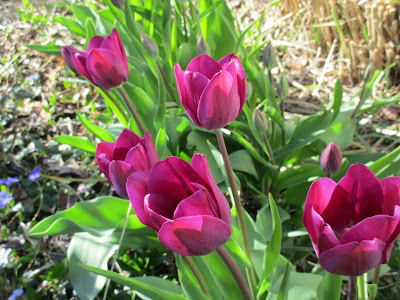 There comes the day, always in April, when all your clothes are suddenly too heavy. They're the same clothes that have been hanging around for most of six months, so it shouldn't come as a surprise, but it always does.
There comes the day, always in April, when all your clothes are suddenly too heavy. They're the same clothes that have been hanging around for most of six months, so it shouldn't come as a surprise, but it always does.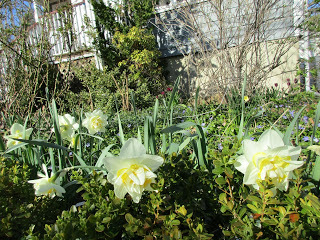 The jeans, that were never really warm enough when you wanted to go for a walk in the winter (and would be disastrous in snow if you got them wet), well, they're also not right when the temperature shoots up into the seventies. The long-sleeved pullovers, and sweaters, and flannel shirts: all too warm.
The jeans, that were never really warm enough when you wanted to go for a walk in the winter (and would be disastrous in snow if you got them wet), well, they're also not right when the temperature shoots up into the seventies. The long-sleeved pullovers, and sweaters, and flannel shirts: all too warm.
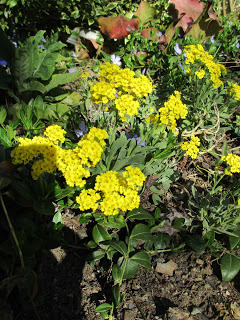 This happens in April. The temperature, expected to go up well into the sixties one day, goes up into the seventies instead. Maybe it's because the steady wind off the ocean along the coast that has been chilling us nicely with us for weeks takes an unexpected break. Next day when the temperature is supposed to reach the seventies, it shoots up near eighty (according to the house thermometer, which I admit is at a times a great kidder). In any event it feels like eighty. The kids who've been dying to wear their shorts all winter are wearing their shorts today. But not you. Your summer clothes are buried in a box somewhere on another floor of the house. You're in no mood to look for them. You're in a mood to sit in the grass somewhere; find some shade. Because it's April, and a lot of the month has been parka weather rather than shorts weather, the trees are not leafed out yet. Most of them are showing their buds, but just this week. So there really isn't a lot of shade yet. And, besdies, even more than relaxing the shade, what you really want to do is make all your spring flowers bloom. April is a great mointh for patience. Not for showing it, but for telling you that you need it.
This happens in April. The temperature, expected to go up well into the sixties one day, goes up into the seventies instead. Maybe it's because the steady wind off the ocean along the coast that has been chilling us nicely with us for weeks takes an unexpected break. Next day when the temperature is supposed to reach the seventies, it shoots up near eighty (according to the house thermometer, which I admit is at a times a great kidder). In any event it feels like eighty. The kids who've been dying to wear their shorts all winter are wearing their shorts today. But not you. Your summer clothes are buried in a box somewhere on another floor of the house. You're in no mood to look for them. You're in a mood to sit in the grass somewhere; find some shade. Because it's April, and a lot of the month has been parka weather rather than shorts weather, the trees are not leafed out yet. Most of them are showing their buds, but just this week. So there really isn't a lot of shade yet. And, besdies, even more than relaxing the shade, what you really want to do is make all your spring flowers bloom. April is a great mointh for patience. Not for showing it, but for telling you that you need it.
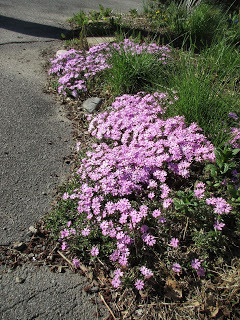 The main thing that happens when the temperature shoots up in the third week of April is the tulip buds you've been inspecting for a week or two begin to open. Some years this doesn't happen until May, so your patience is rewarded early this year. Now you are happy that you devoted a period of a considerably chillier recent afternoon cutting off several hundreds (but who's counting?) of last year's dried, yellow-brown very tall blades of the ornamental grasses smack up against the house's foundation... so that this year you can actually see the line of dark pink tulips that bloom right in front of them. This year April said, 'Good on you. Here are your tulips.' I may have said some ungenerous thngs about Aprils in previous years, for that matter I probably said such things just a few weeks ago this April, but let's enjoy a winning streak when we have one. The narcissus daffodils (second photo down) I planted last year bloomed pretty much the same day. One day, that is, I noticed two or three blossoms showed. The next day, a warm one, a dozen. The grape hyacinth blossoms (they look like upside down grape bunches, the blossoms turn more blue than wine-colored in the photographs), and which constitute the only successfully enduring colony in the earth around the hungry roots of the maple tree, have been been shining for a couple of weeks. April has been good to them too -- or to me, through them. The bright early yellow blossoms are Alyssum Saxatile (third photo). Pachysandra shows its modest little white blossoms, just to let you know they're still in there trying and have a jump on pretty much everything else.
The main thing that happens when the temperature shoots up in the third week of April is the tulip buds you've been inspecting for a week or two begin to open. Some years this doesn't happen until May, so your patience is rewarded early this year. Now you are happy that you devoted a period of a considerably chillier recent afternoon cutting off several hundreds (but who's counting?) of last year's dried, yellow-brown very tall blades of the ornamental grasses smack up against the house's foundation... so that this year you can actually see the line of dark pink tulips that bloom right in front of them. This year April said, 'Good on you. Here are your tulips.' I may have said some ungenerous thngs about Aprils in previous years, for that matter I probably said such things just a few weeks ago this April, but let's enjoy a winning streak when we have one. The narcissus daffodils (second photo down) I planted last year bloomed pretty much the same day. One day, that is, I noticed two or three blossoms showed. The next day, a warm one, a dozen. The grape hyacinth blossoms (they look like upside down grape bunches, the blossoms turn more blue than wine-colored in the photographs), and which constitute the only successfully enduring colony in the earth around the hungry roots of the maple tree, have been been shining for a couple of weeks. April has been good to them too -- or to me, through them. The bright early yellow blossoms are Alyssum Saxatile (third photo). Pachysandra shows its modest little white blossoms, just to let you know they're still in there trying and have a jump on pretty much everything else.
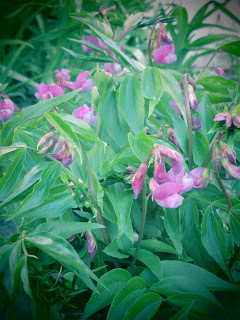 The April bloomer called Spring Vetch (photo left) also kicks up its heels. The low early-blooming phlox (fourth photo down) hugs the sidewalk, enjoying its moment in the sun.
The April bloomer called Spring Vetch (photo left) also kicks up its heels. The low early-blooming phlox (fourth photo down) hugs the sidewalk, enjoying its moment in the sun.
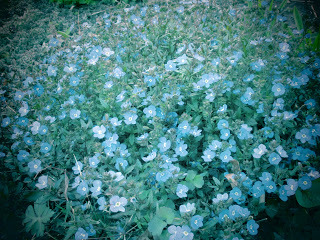 The blue speedwell (photo left) keeps its color even in the shady afternoons behind the house. The back of the house garden is partial sun, especially in the months before the sun is at its full height. Plants in the back are always behind their sun-filled cousins in the front, known locally as the sunny side of the street. But I see the sun shining again this morning, and I do believe I'll be paying a visit to the tulips and daffodils that are opening back there.
The blue speedwell (photo left) keeps its color even in the shady afternoons behind the house. The back of the house garden is partial sun, especially in the months before the sun is at its full height. Plants in the back are always behind their sun-filled cousins in the front, known locally as the sunny side of the street. But I see the sun shining again this morning, and I do believe I'll be paying a visit to the tulips and daffodils that are opening back there.
Published on April 23, 2016 22:04
The Garden of the Seasons: Remember me? I'm Arpril
Published on April 23, 2016 22:04
April 19, 2016
The Garden of Spring Arrivals: Suosso's Lane Comes to Kingston
 I'm cleaning up my act and taking it on the road. (Is that how that expression goes? I can't remember exactly.)
I'm cleaning up my act and taking it on the road. (Is that how that expression goes? I can't remember exactly.)I'll be speaking on "Suosso's Lane" in Kingston, MA on Thursday, April 28, 7 p.m. at the Kingston Senior Center, 30 Evergreen St., in the Kingston Spring Author Talks sponsored by the Kingston Library.
Kingston is not far from Plymouth, MA, where the book is set. Suosso's Lane is a street in North Plymouth where Vanzetti lived for about five years. He was still living in Plymouth, though on another street a few blocks away (Cherry Street) when he was arrested and charged with the crime that tuned into the international affair, the Sacco-Vanzetti case. My first book program took place at the Plymouth Public Library and attracted a big audience, drawing on local interest in the subject.
I'm hoping that some of that interest spread out, or leaks out, or otherwise disseminates beyond the municipal borders of the fair and history-proud township of Plymouth.
Speaking of history, I do have some of my own with the town of Kingston. Before the Boston Globe downsized its South regional section from two papers a week to one edition a week, I covered Kingston. I wrote little news briefs on a weekly basis, calling up folks such as the town clerk to find out the latest list of who was running for office and who had dropped out of the race by not turning in their nomination papers in time. Or the police chief, on various matters, including drugs. Or various local government offices on (in latter days) whoever was complaining about the noise form the town's wind turbine. One thing we have learned about wind turbines is they are marvelously effective in improving the hearing of certain residents who live what appears to be reasonably far away from them.
On the other hand, to be perfectly fair, when a neighbor plants a tree directly in your line of sight on the ocean it proves hard for months to see anything else. And when another neighbor (in another town) triples their house size over your back fence, it becomes difficult for a while to remember that the sky is still there.
Enough with these petty complaints. Kingston has always been a good neighbor for a journalist. When the state decided to reanimate the long-lapsed Old Colony Railroad it determined the best place to terminate the line was in Kingston, even though (as Plymouth officials pointed out) the term "Old Colony" has always referred to their "old" Pilgrim-planted town.
And when a big shopping mall company decided to build its state of the art regional consumer paradise, it chose a location in Kingston, thereby sending Plymouth's Main Street old-school retail economy into a death spiral. This of course ultimately did that town a favor since Main Street has recovered with its current leisure-time and tourist economy based almost entirely on restaurants, bars and antiques (enriched by some entertainment meccas that did not exist until recent years).
Special friends live in Kingston as well, some of whom have particularly endeared themselves to me by becoming early readers and supporters of "Suosso's Lane." Sara Altherr is a friend and colleague from my years working for the Old Colony Memorial, the local newspaper that remains a valuable community resource. Full disclosure: the OCM has very been very good to me and "Suosso's Lane."
My friend, the painter Carole Bolsey, also lives in Kingston. I can't ever look at her paintings without feeling more alive than I did the moment before.
In addition to which my Kingston friends and contacts all seem to live in beautiful homes on beautiful sites. Does it have something to do with the Jones River, a historic Colonial ship-building site whose local prominence has proved a catalyst for a vibrant conservation movement...?
Will I ever stop saying nice things about Kingston?
Well, not before I mention the library, which promotes the community's cultural life with public programs such as the Kingston Library Author Series. Here's what the library director Sia Stewart kindly wrote about my upcoming visit:
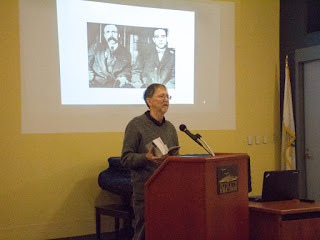 The 1920 Sacco-Vanzetti trial remains one of the most controversial legal cases of modern times. Two Italian immigrants, targeted for their political views, were convicted of a murder-robbery in a trial marred by weak evidence and judicial prejudice. They were executed seven years later despite international protests. In his novel, named after the street in Plymouth where Bartolomeo Vanzetti lived for five years, author Robert Knox provides a contemporary setting for a rearview look at the early 20th century trial of Italian immigrants Nicola Sacco and Bartolomeo Vanzetti.
The 1920 Sacco-Vanzetti trial remains one of the most controversial legal cases of modern times. Two Italian immigrants, targeted for their political views, were convicted of a murder-robbery in a trial marred by weak evidence and judicial prejudice. They were executed seven years later despite international protests. In his novel, named after the street in Plymouth where Bartolomeo Vanzetti lived for five years, author Robert Knox provides a contemporary setting for a rearview look at the early 20th century trial of Italian immigrants Nicola Sacco and Bartolomeo Vanzetti.Robert Knox lived in Plymouth for 20 years before moving to Quincy, where he has lived for the last 10 years. He graduated from Yale University and taught English at Boston University and other colleges. He is a correspondent for The Boston Globe, and his poems, creative nonfiction and short stories have appeared in numerous literary publications.
Light refreshments will be offered and although the program is free, reservations are requested.
For more information or to register, visit the library’s online calendar at www.kingstonpubliclibrary.org or call the library at 781-585-0517, Ext. 112.
Published on April 19, 2016 09:10
April 17, 2016
Garden of the Absurd: Silly Fruit on the Cherry Tree
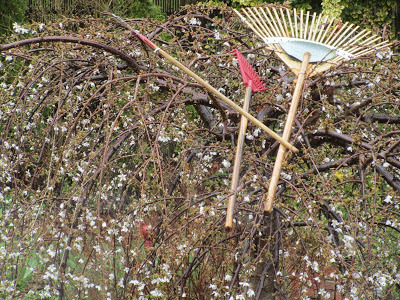
It started a couple of years ago, and now I've come to expect it. I'm resigned to it, I told myself. The Japanese weeping cherry tree that we planted in part because of the beautiful white blossoms ballooning around it like a shapely white skirt during its all too brief flowering season has turned into a garden party for birds who tear off the blossoms before they fully open and toss the drop of nectar inside down their gullet. This practice, amusing and no doubt satisfying some primal urge for the birds who do it, essentially denudes the tree of blossoms before that picturesque white fountain effect comes to pass.
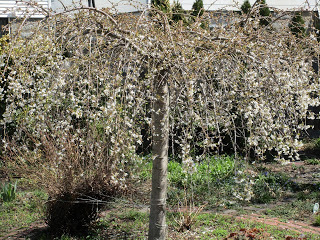 Anyway, the flower buds began to show early in April this year following a warmer than average winter. Then came the Sunday snow morning that melted during the same day. Then came the Monday snow that kept up all day and sat on the buds and on some half-open blossom. After this, some of the blossoms had that washed out appearance a rag or some small article of clothing gets when it sits in a puddle all day. The snow disappeared, the weather normalized, the white buds and half-opened blossoms began to dry out. Then came the birds. I watched them perch the umbrella shaped nexus of branches at the top of the tree, get comfortable, tie their napkins under the necks, take out the cutlery, grab a blossom in their beak and toss it into the air. I watched the ground beneath the tree fill up with discarded blossoms. No white cherry tree bloom time appears likely this year. I opened the window of my study and yelled at the birds. This kept them away about two-three minutes. Maybe half a minute after the second or third time. Even then I had to get really extravagant in the vocalization department to get the last bold fellow off the tree. It was a finch, with a lot of brilliant dark pink color around the head and neck. A prince among finches. a natural leader. I noticed no birds on the tree until he came along and set up shop. Then a few others quickly followed. I walked to the bedroom, opened a window (temperature 'moderate' for April) and gathered tiny gravel pebbles to throw at the birds when they next appeared. The plan is I stand guard in my bedroom, with the window open, in April, ready to throw pebbles at birds. This is ridiculous, I decide, after thought. Similarly, I can go outdoors and stand next to the tree, ready to wave my arms and scare away the blossom marauders the moment they arrive. But then I wouldn't be sitting at my desk pursuing immortality at my keyboard. Another sensible plan goes down to a minor flaw. So then, because the other choices were ridiculous, and also because I have taken to shaking a bamboo leaf rake at the birds during my frequent forays outdoors to discourage them, I decide to build a scarecrow version of myself shaking a rake at the sky. This fantasy lasts even less time than it takes to relate. How can I make an effective scarecrow unless I decide to stuff myself? So then (no appetite for stuffing) I come up with a brilliant flash of inspiration. I will turn the tree itself into a scarecrow by tossing the rake on top of the still near-blossoming weeping cherry tree. Surely the birds will be frightened by the rake, an obvious man-thing, and realize that the man is probably just about to appear and wave his arms and frighten them muchly, and so they will keep away from the tree... This worked, the first time at least, for about an hour. Then the red-necked finch came back and found a comfortable perch on the tree right next to the rake's bamboo flanges, if not right on top of them, and went to back to work on the blossoms. His followers promptly followed. I decide the problem is an insufficiency of rakes. I find two other, smaller leaf rakes, and manage to toss them on top of the cherry tree as well, (The tree is now feeling very foolish.) But this plan almost worked. It kept the finches off the tree for a little while, as long as I punctuated my day with visits to the tree about every half hour or so in which I stood next to the tree, jumped up and down waving my hands exuberantly back and forth, and shouting extravagant threats at the top of my lungs. Somehow the neighbors have still not called the police. What really happened is that most of the blossoms were by now consumed. The tree wore its crown of rakes on the center of its blossom-bare scalp, and the white flowers opened on the lower, weeping branches, where presumably it's a little less comfortable for a bird to stand and peck. And so our cherry tree had its annual spring semi-blossom. [Top photo, tree with rakes; second photo last week's tree in semi-bloom. Below, for comparison, the tree in previous years] I do not think that Basho, or the other Japanese poets who worshiped the spring ritual of the blossoming of the cherry trees, would be much impressed. To seeker a more enlightened view of cherry blossom time, some three-line poems by the classic poet Basho on this season in Japan, gathered from the internet:
Anyway, the flower buds began to show early in April this year following a warmer than average winter. Then came the Sunday snow morning that melted during the same day. Then came the Monday snow that kept up all day and sat on the buds and on some half-open blossom. After this, some of the blossoms had that washed out appearance a rag or some small article of clothing gets when it sits in a puddle all day. The snow disappeared, the weather normalized, the white buds and half-opened blossoms began to dry out. Then came the birds. I watched them perch the umbrella shaped nexus of branches at the top of the tree, get comfortable, tie their napkins under the necks, take out the cutlery, grab a blossom in their beak and toss it into the air. I watched the ground beneath the tree fill up with discarded blossoms. No white cherry tree bloom time appears likely this year. I opened the window of my study and yelled at the birds. This kept them away about two-three minutes. Maybe half a minute after the second or third time. Even then I had to get really extravagant in the vocalization department to get the last bold fellow off the tree. It was a finch, with a lot of brilliant dark pink color around the head and neck. A prince among finches. a natural leader. I noticed no birds on the tree until he came along and set up shop. Then a few others quickly followed. I walked to the bedroom, opened a window (temperature 'moderate' for April) and gathered tiny gravel pebbles to throw at the birds when they next appeared. The plan is I stand guard in my bedroom, with the window open, in April, ready to throw pebbles at birds. This is ridiculous, I decide, after thought. Similarly, I can go outdoors and stand next to the tree, ready to wave my arms and scare away the blossom marauders the moment they arrive. But then I wouldn't be sitting at my desk pursuing immortality at my keyboard. Another sensible plan goes down to a minor flaw. So then, because the other choices were ridiculous, and also because I have taken to shaking a bamboo leaf rake at the birds during my frequent forays outdoors to discourage them, I decide to build a scarecrow version of myself shaking a rake at the sky. This fantasy lasts even less time than it takes to relate. How can I make an effective scarecrow unless I decide to stuff myself? So then (no appetite for stuffing) I come up with a brilliant flash of inspiration. I will turn the tree itself into a scarecrow by tossing the rake on top of the still near-blossoming weeping cherry tree. Surely the birds will be frightened by the rake, an obvious man-thing, and realize that the man is probably just about to appear and wave his arms and frighten them muchly, and so they will keep away from the tree... This worked, the first time at least, for about an hour. Then the red-necked finch came back and found a comfortable perch on the tree right next to the rake's bamboo flanges, if not right on top of them, and went to back to work on the blossoms. His followers promptly followed. I decide the problem is an insufficiency of rakes. I find two other, smaller leaf rakes, and manage to toss them on top of the cherry tree as well, (The tree is now feeling very foolish.) But this plan almost worked. It kept the finches off the tree for a little while, as long as I punctuated my day with visits to the tree about every half hour or so in which I stood next to the tree, jumped up and down waving my hands exuberantly back and forth, and shouting extravagant threats at the top of my lungs. Somehow the neighbors have still not called the police. What really happened is that most of the blossoms were by now consumed. The tree wore its crown of rakes on the center of its blossom-bare scalp, and the white flowers opened on the lower, weeping branches, where presumably it's a little less comfortable for a bird to stand and peck. And so our cherry tree had its annual spring semi-blossom. [Top photo, tree with rakes; second photo last week's tree in semi-bloom. Below, for comparison, the tree in previous years] I do not think that Basho, or the other Japanese poets who worshiped the spring ritual of the blossoming of the cherry trees, would be much impressed. To seeker a more enlightened view of cherry blossom time, some three-line poems by the classic poet Basho on this season in Japan, gathered from the internet: Between our two lives
there is also the life of
the cherry blossom.
If I had the knack
I'd sing like
Cherry flakes falling
The oak tree stands
noble on the hill even in
cherry blossom time
A lovely spring night
suddenly vanished while we
viewed cherry blossoms
Kannon's tiled temple
roof floats far away in clouds
of cherry blossoms
(Kannon is the Bodhisattva of Compassion)
From all these trees –
in salads, soups, everywhere –
cherry blossoms fall
How many, many things
They call to mind
These cherry-blossoms!
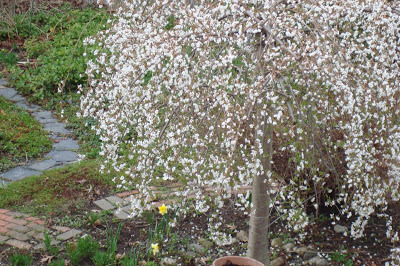
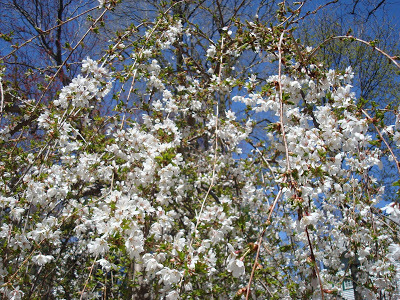
Published on April 17, 2016 10:51

